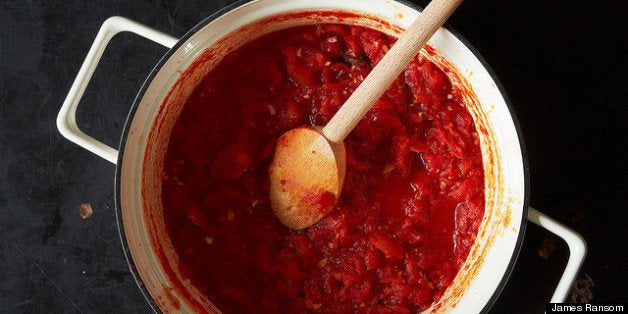
At Food52, we love recipes -- but do we always use them? Of course not. Because once you realize you don't always need a recipe, you'll make your favorite dishes a lot more often.
Today: How to make fresh marinara in 20 minutes flat, with variations. You'll never want to buy the jarred stuff again.
Homemade marinara sauce is my culinary version of the little black dress, and can be reliably dressed up or down with delicious ease.
My marinara is a simple tomato sauce that can be made with just six ingredients that you probably already have in your pantry — high quality tomatoes (canned are perfectly acceptable in my book!), extra virgin olive oil, garlic, kosher or sea salt, freshly ground black pepper, and a fresh herb or two. Plus it is very quick to put together. If you have twenty minutes, you can easily cook this dish. Once it is in your cooking rotation, I guarantee that you will never buy jarred tomato sauce again.
How to Make a Marinara Sauce in 20 Minutes
1. Finely chop your garlic. Let the size of your cloves and how much you like the flavor of garlic be your guide. I like about four cloves.
2. If you are cooking during the summer or fall months, use fresh, ripe, locally grown tomatoes. I like to chop cherry tomatoes, skins and all, but if your tomatoes are very thick-skinned, give them a quick blanch in boiling water before peeling and dicing them.
If using canned tomatoes, splurge on an excellent brand, preferably with little or no salt and no added herbs, packed in their own juices (not tomato sauce). Drain canned tomatoes and reserve the liquid, so as to avoid an overly watery sauce. If you are using whole tomatoes, my preferred method is to squeeze the tomatoes with my hands to create small chunks. Warning: this is kind of messy because tomatoes will squirt — I recommend wearing an apron! Diced canned tomatoes can be used as is.
3. Coat your pan with olive oil and sauté the garlic over low heat. (If you are serving pasta, now is the time to put your salted water on to boil.) When the garlic is soft and fragrant, add prepped tomatoes to your pan.
4. Turn up the heat and let the tomatoes reduce and thicken slightly. I like to add a handful of fresh herbs (both leaves and stalks), such as basil and parsley, and let them poach in the sauce — a tip that I learned from Lidia Bastianich's wonderful cookbook, Lidia’s Family Table.
5. If your marinara is looking too thick, add some reserved tomato water or pasta water. Add salt and a grind or two of black pepper until flavors taste balanced. Remove herb stalks and leaves from sauce. That’s it! Marinara sauce is now ready to eat.
How to Use It
If you have a basic marinara in your pantry, you have the building blocks for many delicious dinners. I use it to top homemade pizza, stuff calzones, and to make fantastic chicken and eggplant parmigiana. A spoonful or two transforms risotto into something special. But it’s pretty darn good, just on its own, served with pasta (fresh or dried), frozen ravioli, or even cooked farro. If you are serving with pasta or farro, combine preferably in a skillet over medium heat, so that sauce and pasta can marry together.
Variations
Marinara has a beautiful simplicity that I adore. But when a straight marinara just won’t do, there are some easy ways to fancy it up.
- Make a quick puttanesca. If you have any anchovies, chop one or two up and add them to your sautéed garlic before you begin reducing your tomatoes. Add a spoonful of chopped capers and a handful of chopped, pitted olives to the sauce during the last 5 minutes of cooking.
- To add depth of flavor to a marinara, begin by sautéing some diced pancetta or guanciale (or even bacon in a pinch) with a little olive oil.
- Make a vegetable ragu. Sauté half of your minced garlic along with a chopped onion or leek. Add whatever vegetables you have in your fridge, cut into bite-sized pieces, such as fennel, asparagus stalks, tender chard stems, blanched fava beans, or mushrooms. When vegetables are just fork tender, remove from pan and add them back in the last 5 minutes of cooking. Fresh or frozen peas, asparagus tips, or julienned Swiss chard can also be added at this point.
Still want a recipe? Here are a few for inspiration:
Photos by James Ransom
Food52 is a community for people who love food and cooking. Follow them at Food52.com -- and check out their new kitchen and home shop, Provisions, to get $10 off!